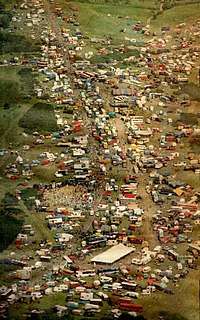Castlemorton Common Festival
The Castlemorton Common Festival was a week-long free festival and rave held in the Malvern Hills near Malvern, Worcestershire, England between 22 and 29 May 1992.[1] The media interest and controversy surrounding the festival, and concerns as to the way it was policed, inspired the legislation that would eventually become the Criminal Justice and Public Order Act 1994.[2][3]
| Castlemorton Common Festival | |
|---|---|
 | |
| Genre | Breakbeat Hardcore, Techno, House, Anarcho Punk |
| Dates | 22–29 May 1992 |
| Location(s) | Malvern, Worcestershire, England |
| Years active | 1992 |
| Attendance | 20,000 – 40,000 |
Background
In May 1992 Avon and Somerset Police tried to end the annual Avon Free Festival, which had been held in the Bristol area around the May Bank Holiday for several years.[4] As a result, hundreds of new age travellers en route to the area for the expected festival were shunted into neighbouring counties by Avon and Somerset's Operation Nomad police manoeuvres, with West Mercia Police deciding to confine them to common land at Castlemorton.[1]
Events
The first travellers arrived on the common on 22 May, but the high-profile coverage in the national media only served to swell the crowd further as ravers from far afield made their way to join the festival, thus making it an impossible task for the authorities to close the event down.[3] An estimated 20,000–40,000 people gathered on Castlemorton Common for the party which lasted a full week, the biggest of its kind since the Stonehenge Free Festival in the mid-1980s.[5]
Castlemorton hosted many of the large sound systems of the time such as Bedlam, Circus Warp, Spiral Tribe and DiY Sound System, and bands such as Back To The Planet, Xenophobia (fronted by Spiral Tribe's MC Skallywag), AOS3 and Poisoned Electrick Head.[6][7]
Simon Reynolds wrote that "during the next five days of its existence, Castlemorton will inspire questions in Parliament, make the front page of every newspaper in England and incite nationwide panic about the whereabouts of the next destination on the crusty itinerary." [8]
Speaking in a House of Commons debate, the local MP at the time, Michael Spicer, opined, "new age travellers, ravers and drugs racketeers arrived at a strength of two motorised army divisions, complete with several massed bands and, above all, a highly sophisticated command and signals system. However, they failed to bring latrines. The numbers, speed and efficiency with which they arrived—amounting at one time to as many as 30,000 people—combined to terrorise the local community to the extent that some residents had to undergo psychiatric treatment in the days that followed. Such an incident must never happen again, in my constituency or elsewhere. We need tighter laws, especially to give banning powers to the police; a Cabinet Committee to bring responsible Departments together; quicker and more co-ordinated police action; and a more effective application of existing policies by national and local authorities."[9]
Outcome
Thirteen members of Spiral Tribe were arrested after the event, and charged with public order offences. After a lengthy and costly trial, they were acquitted.[1]
Concerns about the festival and the way in which it was policed inspired the legislation which developed into the Criminal Justice and Public Order Act 1994.[2] This wide-ranging Act effectively made illegal such outdoor parties playing music that, as defined in section 63(1)(b), incorporates "sounds wholly or predominantly characterised by the emission of a succession of repetitive beats".
Whilst some have argued that Castlemorton, with its attendant publicity, led directly to the Criminal Justice Act and was the "final nail in the coffin of the unlicensed event",[10] others have seen the Act as a draconian piece of legislation which was "explicitly aimed at suppressing the activities of certain strands of alternative culture".[11]
See also
References
- Lynskey, Dorian (15 June 2011). "Castlemorton triggers the rave crackdown". The Guardian. Retrieved 26 May 2016.
- Fielding, N. (2005) The Police and Social Conflict, Page 113, Routledge Cavendish ISBN 1-904385-23-0
- Chester, Jerry (28 May 2017). "Castlemorton Common: The rave that changed the law". BBC News. Retrieved 28 May 2017.
- McKay, G. (1996) Senseless Acts of Beauty: Cultures of Resistance, Page 120, Verso ISBN 1-85984-908-3
- During, S. (2005) Cultural Studies: A Critical Introduction, Page 131, Routledge ISBN 0-415-24656-3
- Whitehurst, Andrew (28 March 2014). "Free Party Politics: Castle Morton". DJ Mag. Retrieved 15 April 2016.
- Carney, B. (2010) Take Your Protein Pills..., Page 141, Lulu ISBN 978-1-4452-6411-0
- Reynolds, S. (1998) Energy Flash, Pages 135-140, Picador ISBN 0-5712-8914-2
- Parliamentary Debates (Hansard). 6, 210. House of Commons. 29 June 1992. col. 688.
- ed. South N. (1999) Drugs: Cultures, Controls and Everyday Life, Page 30, SAGE Publications ISBN 0-7619-5235-7
- Gilbert J. (1999) Discographies: Dance Music, Culture, and the Politics of Sound, Page 150, Routledge ISBN 0-415-17032-X
External links
- Castlemorton Festival on Free Party People
- Press clippings on the DJ Riddler Rave Website
- Castlemorton rave diary on Loftsites
- Castlemorton photographs on Alan 'Tash' Lodge Website
- Festival account on BeyondTV
- Criminal Justice Bill Public Order: Collective Trespass on Legislation.gov.uk